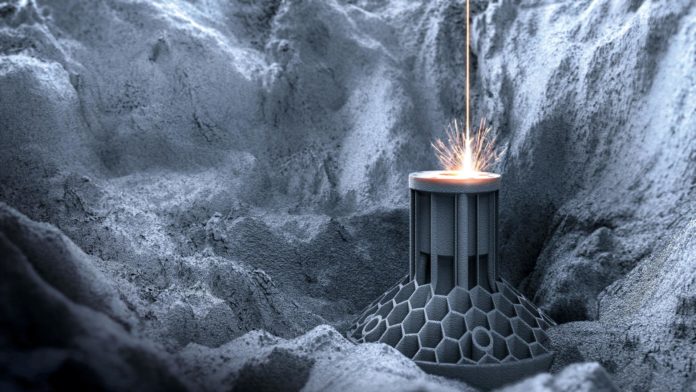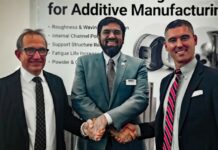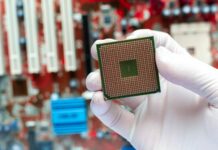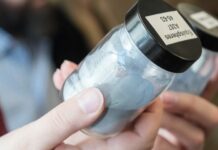Metal powders are the base materials for powder metallurgy operations such as uniaxial pressing and some types of additive manufacturing processes. These operations have already demonstrated that somehow, metal powders characteristics play a big role in the properties of the end-product. This role necessarily depends on the quality of the material, the printing process and costs (material cost vs cost of the printed part). This article will discuss these points.
There are various techniques to produce metal powders and each of these techniques delivers a unique morphology and properties to metal powders. Despite these differences in the way they are produced, metal powders must include properties that ensure repeatable manufacturing of metallic parts. Indeed, metal powders designed for additive manufacturing are spherical and their particle size distribution aims to ease good packing behavior. This way, the finished printed part integrates desired mechanical properties. However, before getting to the end-part, there are too many factors to discuss. One of these factors is the quality of the powder vs its price.
Does the quality of the metallic powder impact its price?
Materials price is definitely an important issue for manufacturers because, as we said earlier, they constitute an essential part of powder metallurgy operations. So, their choice matters to achieve the desired finished part.
Furthermore, given the fact that, in the additive manufacturing industry, metal additive manufacturing remains one of the most expensive additive manufacturing technologies, manufacturers often believe that purchasing a “cheap powder” would not affect the quality of the finished product.
First, the term “cheap” might be tricky itself, because, before anything else, a product is often considered “cheap” according to the buyer’s budget. Furthermore, it goes without saying that the price of a specific metallic powder varies from one producer to another, and obviously, this price is based on the quality of the metallic powder.
For LPW Technology, a materials producer, quality “means consistency of supply, full traceability and reliable material performance. Consistency of supply and traceability are factors which are controlled by robust Quality Management Systems, optimised manufacturing methods and trusted supply chains”.
In general, features that enable to profile powder specification and quality include physico-chemical properties, chemical compositions and purity, morphology, apparent or packed density, specific surface, granulometry, and grain porosity.
According to Valentina Vicario, Technical Manager of MIMETE, producer of metal powders, among all of these features, “the first feature that impacts the powder price is obviously chemical composition. Usually Fe powders are less expensive than Ni, Co and Ti-base ones. Inside every “family” of alloys, there are expensive alloys, usually customized and/or characterized by special combination of elements, and other “commodities”, less demanding and more widely spread. In general, the more numerous and stricter are requirements on different powder properties (chemical analysis, granulometric range, density, etc.), the higher is the cost, because special customized processes are required and production planning can be heavily affected.”
Another aspect that can influence the choice of a specific metallic powder is the ability to reuse a batch of material. The user or a specific industry standard can determine the number of times a material can be reused but properties delivered in the printed parts (material performance) will be the key performance indicator of the powder’s quality.
Valentina Vicario from Mimete precises that “powder recycling is possible, but can be applied only for some alloys and for some applications. After a first usage, depending on printing parameters (i.e. protective atmosphere), powder can be affected by oxidation and agglomeration: a sieving is always needed to remove clusters and deformed particles before a new printing process, while higher oxygen content might theoretically reduce mechanical properties of the parts printed by the second cycle.”
Speaking of metal powders designed for additive manufacturing, LPW explains in a case study that: “Oxygen levels in powder are primarily driven by oxygen levels in the feedstock material, the process parameters and gas purity used during atomization. For this reason, it is typically more costly to produce powders with low oxygen levels. It may seem more cost effective to use powder with a higher oxygen content but at a lower cost, but this is only true if a user does not consider reusing the metal powder.”
LPW & Mimete raise through these statements, another issue that impacts both the price of a metallic powder and the price of the printing process: gases.
The impact of metallic powders on the finished printed part
During an interview, Pierre Forêt, Head of the AM unit at Linde, told us that customers often worry about the purchase of metallic powders – especially titanium whose price can go up to 300€ per kg. Speaking of one customer that needed to buy a significant amount of powder, he explained that, “in addition to be expensive, the powder is very sensitive to humidity, which means that it is easy to lose the essence of the powder; and that will definitely impact the printing process. In order to avoid this waste of money, the ideal solution was to develop a system that could both spur the powder and remove humidity.”
Mimete reminds that powder properties have a strict relationship with final printed part features. Multiple and complex correlations can be found as demonstrated by the chart below:
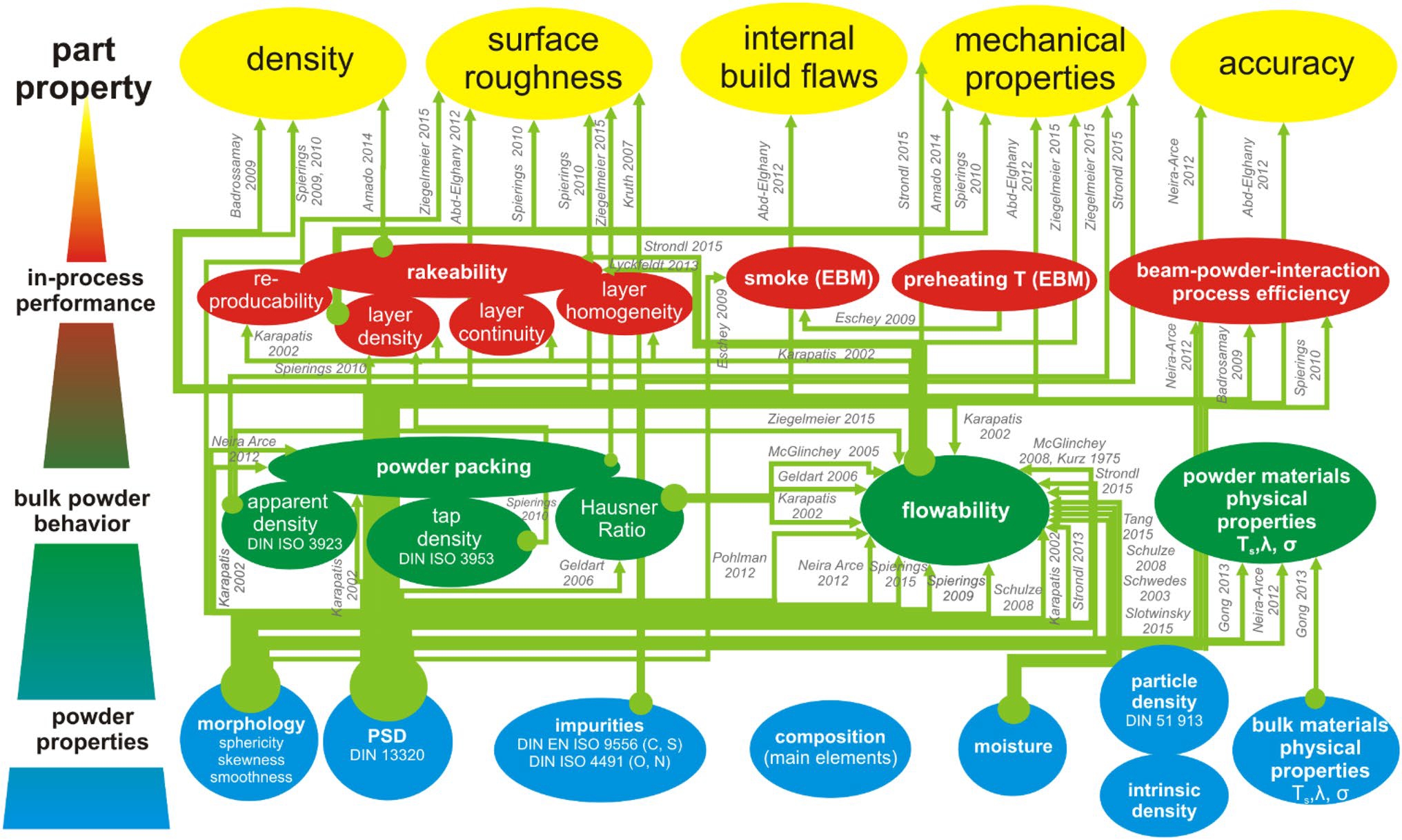
Let’s take the example of Powder-Bed AM technologies, which are the most common used metal AM techniques within the demanding industries. Powder-Bed EBM is one of the rare technologies that can achieve full-density metallic parts.
The density of the powder layers as well as the porosity of the particles themselves are important factors for this printing process. Indeed, true density is an inherent property of a material, while apparent density takes into consideration any occluded voids within a material.
Users should therefore be aware of the true and/or apparent density of a material feedstock since it allows to achieve powder bed formation and sintering kinetics in the AM process as well as the porosity, or lack of porosity in the end product.
What about the final cost per part?
Several factors can influence the final cost per part. Additive manufacturing systems, machine
data, materials, construction job parameters, consumables data or even operational calculations are some of the factors that can influence the final cost per part.
At the materials level, it should be noted that AM technologies can be complementary. Indeed,
manufacturers can take advantage of the benefits brought by two technologies. Furthermore, the
increasing use of AM may result in a reduction in raw material cost through economies of scale.
According to Thomas Douglas’ research on “Costs, Benefits, and Adoption of Additive Manufacturing: A Supply Chain Perspective”, “the reduced cost in raw material might then propagate further adoption of additive manufacturing. There may also be economies of scale in raw material costs if particular materials become more common rather than a plethora of different materials.”
As far as metal AM processes are concerned, Mimete believes that, “the cost of the powder might affect the final cost of the part from less than 10% to 20-30% depending on the alloy and the complexity of the printed component.”
LPW Technology on the other side, explains that two other key factors that influence the final cost per part are the number of viable builds that can be completed from a single batch of powder, and the number of parts that can be produced in each build. “The number of parts produced in a single build depends on the size of the part and the size of the available build volume. The number of builds that can be completed for a single batch is dependent on how quickly the powder breaches the specification limits. At this point we must consider the influence of powder evolution, how a material varies from initial specification.”
In a nutshell…
Cost has always been (and will certainly always be) the holy grail for OEMs and other industrials.
There are too many factors to take into account, and every choice should be made wisely.
At the materials stage, controlling the dimensional characteristics is one of the main reasons that explains the success of powder metallurgy processes, and AM processes in particular.
In other terms, controlling the characteristics of materials in additive manufacturing should enable professionals to produce high volumes of duplicate parts with desired properties, and of course at a reasonable price compared to other metal-fabrication processes. So far, demanding industries such as automotive or aerospace have been able to take advantage of this solution.



